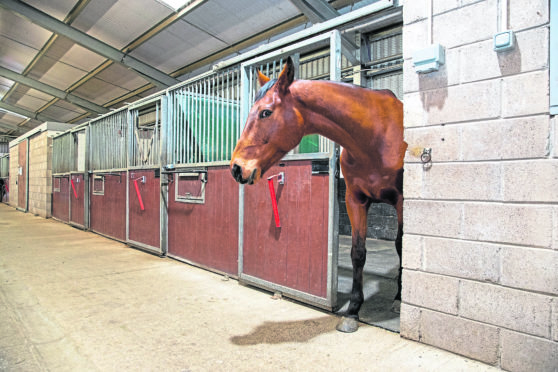
Horses could give escapologist Harry Houdini a run for his money.
Researchers have discovered there is almost no lock, gate or door that can bar their way.
A new study has found: “no obvious limit to the complexity which horses can learn to master.”
The horses use their teeth, lips, tongues and a little shoulder power to lift and turn bolts, and manipulate keys, electric fences, and door handles, often in order.
The researchers studied more than 400 reports – backed up with videos – and found half the horses could open at least two kinds of mechanisms, and some as many as five.
Many of the horses “broke out” of their stalls to join stablemates, raid feed bins, or take a stroll in the paddock, but a surprising number stayed put, suggesting, according to scientists, they were picking locks for fun.
Report co-author Professor Richard Byrne, of St Andrews University, said: “I was certainly amazed by what we found.
“Pushing bars, or lifting handles are pretty common and something similar might occur in the wild – they are also the commonest fastenings, but some of these more elaborate fastenings, I found it quite shocking that horses were around that could undo them.
“What particularly impressed me – I work mainly with non-human primates, apes in Africa – is how much an animal who basically has only its mouth to do anything with can do, because there is not a lot you can do with a hoof.
He added: “Compared to a chimpanzee with four fingers and a thumb on each hand, you would not be very surprised if a chimpanzee was able to carefully squeeze the handle that attached the electric fence wires to the support, squeeze them, move then out of the way and then chuck them away.
“But when a horse can do it, it is pretty amazing. “
The team – who included scientists from Germany – identified 408 horses capable of opening nearly 600 kinds of closing mechanisms.
Specifically, they managed to break through 43 twist locks, 40 carabiners (rock climbing clips) and even two locks with keys. They released 260 horizontal bars, 155 vertical bars, 42 door handles, and 34 electric fence handles.
The more complex the mechanism was, the more movements were needed – from two for door handles to 10 for carabiners.
But Professor Byrne said some just stayed where they were: “It sounds as if some of them were doing it for fun, doesn’t it? Which is more what you might expect from a non-human primate like a chimpanzee. ‘Here’s a challenge. I’ll defeat the challenge, but I didn’t actually want to go out into the rain.’”
He added: “It is rather nice to find that horses seem to be showing off their abilities making their lives a bit more interesting by cracking a few puzzles.”
The study, which was published in the journal Animal Cognition, concluded: “These horses seemed to have understood the concept of ‘locked doors’.”
Four-time Olympic Silver medallist Ian Stark , who now runs an equestrian centre in Galashiels, said his horses are so adept at opening their doors he has had to change the locks.
“Over the years we have had horses open their doors to the stables. We had the old bolt, but we had to fit safety mechanisms instead, so they could not open them.
“I have never come across them turning keys. The horses that have opened doors and gates, they have learned it themselves.”
“Horses tend to play with a clip or gatelock first. They mouth things anyway, and nuzzle away, and they learn how to do it from that, getting out of their stables, or wherever.”
Shirley Melling, horse unit manager at the The Scottish National Equestrian Centre, Ecclesmachan, said horses’ ability to pick locks is no surprise.
She said: “We have had some really smart ones here, that are very good at opening almost anything, even ones that are supposed to be horse-proof.
“We have had to devise things to try and stop them opening doors that aren’t meant to be opened by horses.
“What we have is 12ft by 12ft stables and they have sliding doors. So the door slides, and first and foremost that is supposed to stop the horse.
“The door slides shut, and once it is slid shut, there’s a metal catch that drops down at the side of the door to stop the door being slid back open.
“It’s a piece of metal that drops with a tiny little less-than-inch long handle on it, that when you want to open the door you lift little piece up, and then slide the door open.”

Enjoy the convenience of having The Sunday Post delivered as a digital ePaper straight to your smartphone, tablet or computer.
Subscribe for only £5.49 a month and enjoy all the benefits of the printed paper as a digital replica.
Subscribe © Kenny Smith
© Kenny Smith